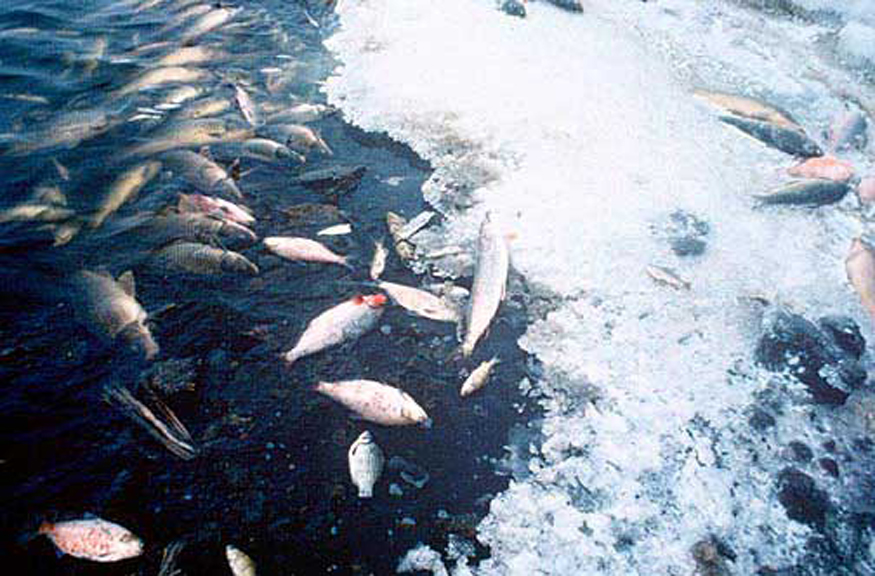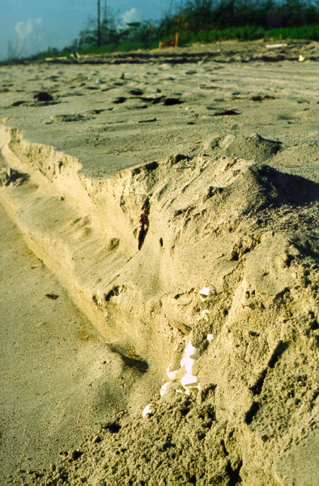Impacts on Aquatic Species Immediately following the passage of a tropical cyclone, aquatic organisms may experience localized mortalities in association with high nutrient loading and subsequent periods of hypoxia (low oxygen levels). Long-term storm effects often include widespread alterations in the distribution, abundance, and movement of mobile aquatic species. Freshwater species may move upstream as storm surge brings high salinity water into the area; species that tolerate low salinities may vacate areas impacted by heavy rainfall (which would decrease salinity), and move downstream into more saline waters. Rising waters may also flood areas that usually do not contain water. After water levels recede, fish and other aquatic animals may become trapped and/or stranded, and die. Recovery following tropical cyclones is usually rapid, however, with a return to pre-hurricane numbers and distribution occurring within a matter of months. Providing that there has not been a loss of critical habitat, animals are able to rapidly repopulate the areas from which they had been displaced.
When hurricane winds strip vegetation and topple trees, a large pulse of litterfall (fallen leaves, branches, and other natural debris) is generated. For example, when Hurricane Iniki (1992) passed over Hawaii, researchers measured a litter fall pulse equivalent to 1.4 times that of the annual litter fall rate. Forty-one percent of the normal seasonal leaf fall occurred during one day in the Atchaflaya Basin in Florida after the passage of Hurricane Andrew (1992). This litter then represents an immense pulse of organic matter to the soil and/or water. Storm-induced litterfall may contain up to 3 to 5 times more nitrogen, phosphorous, magnesium, and potassium than the average, annual literfall for an area. The decomposition of this large amount of organic matter, especially that which has fallen into wetlands and/or riverine habitats, can lead to low levels of oxygen in the water column, as oxygen is used during the decomposition process. This drop in available oxygen may cause the aquatic environment to become hypoxic or anoxic (low or no available oxygen, respectively). This then impacts fish and other animals living in these areas. Fish kills, die-offs of fish that can be massive in proportion, usually occur when oxygen levels are severely depleted. Hurricane Isabel (2003) brought heavy rain and storm surge to North Carolina, flushing out the Roanoke River and its tributaries. This large freshwater discharge (and associated reduction in salinity and available oxygen) caused an extensive fish kill throughout 25km (15.5 mi) of the lower part of the river. Although species richness and abundance for the area was drastically reduced one month after the hurricane, several years later, the fish assemblage did recover from the catastrophic disturbance. Fishermen reported large fish kills in south Florida following Hurricane Andrew (1992), and in the Charleston Harbor region of South Carolina after Hurricane Hugo (1989). In South Carolina, although fish and crab populations were significantly reduced following Hurricane Hugo, increased densities were observed downstream suggesting that animals had moved in response to the altered water quality. This shows how fish and some invertebrates are fairly resilient to the occurrence of natural disturbances, and, similar to birds and other animals, they are highly mobile and can move to more suitable, undisturbed areas before, during, and/or after a tropical weather event.
In addition to fish, other mobile animals such as sea turtles are detrimentally impacted by hurricanes. The Atlantic Basin hurricane season overlaps with prime nesting season for many species of endangered marine turtles including loggerhead (Caretta caretta), leatherback (Dermochelys coriacea) and green (Chelonia mydas) sea turtles. Over 90% of all Western Atlantic loggerhead sea turtle nests occur on the beaches of South Florida, and area heavily impacted by hurricanes and tropical storms. Sea turtles mate in the surf, and females will return to their natal beaches to lay large clutches of eggs. Although storm events appear to have little effect on the actual nesting of adult female sea turtles (although some mortality due to storm surge and heavy waves may occur as turtles enter the beach), hurricanes appear to have a significant impact on sea turtle nest survival. Sea turtle nests can be inundated, washed out, or buried by sand brought in with the high tides and increased wave action associated with a tropical system. Turtle hatchling mortality is generally a result of drowning (due to nest inundation when sand has been eroded), or suffocation (due to the build up of sand on top of the nest, preventing the hatchlings from escaping). Altered beach topography may also prevent hatchlings from successfully reaching the ocean. Many species of sea turtles nest along the beaches at St. George Island and Cape St. George Island in the Apalachicola Bay area, Florida. In 1994, 2 tropical storms and a tropical depression washed out sea turtle nests on both islands, and covered most remaining nests with as much as .4-.6 m of tightly packed sand. In 1995, 3 hurricanes, Allison, Erin, and Opal, caused severe erosion along the islands’ beaches, eliminating more than 40% of the nests. Combined, the 2004 and 2005 seasons have been the worst to date, with 51% and 67% of the islands’ nests destroyed, respectively. Hurricane Andrew (1992) affected turtle nests on over 145 km (~ 90 mi) of beaches on the east and west cast of Florida. The greatest surge effects were felt on beaches closest to the eye of the hurricane, where egg mortality was 100%. In areas further from the eye, the surge was lower and mortality correspondingly decreased. Fixed species such as oysters are also significantly impacted by tropical cyclones. Hurricanes detrimentally impact oyster reefs through physical disturbance (waves pounding into the reefs cause breakage), sedimentation, and extreme salinity changes. These effects are typically due to the storm surge, high winds, and high rainfall associated with each storm. In 1985, Hurricane Elena battered Apalachicola Bay, FL, causing physical damage and structural alteration to oyster reefs in the area. Oyster resources were so severely devastated that commercial harvesting was suspended until a year after the hurricane’s passage. During Hurricane Alberto (1994) Apalachicola Bay, FL oyster reefs did not suffer physical damage, but high river flow resulting form upstream precipitation resulted in extended periods of low salinity (for up to 2 weeks) in the bay area, directly affecting oyster populations and causing extremely high mortality (80-90%). Twenty-five percent of Louisiana’s public oyster seed grounds were virtually wiped out by Hurricane Andrew in 1992, and more recently, Hurricanes Katrina and Rita passed through major Louisiana oyster production areas, causing between 55-70% oyster mortality to the public grounds. Physical damage to oyster reefs may be amplified or lessened by the height of tide when a hurricane makes landfall. Oyster reefs were completely submerged at high tide when Hurricane Dennis made landfall in Apalachicola Bay, FL, in the summer of 2005. Since the reefs were submerged, the force of the surge and wave action was reduced, resulting in little damage to the oyster resources. Coral Reefs
The waves generated by hurricanes are larger and more powerful than those experienced under normal conditions. These large waves can significantly impact coral reef systems. Damage to coral reefs can vary from almost total destruction to no effects at all over a distance of just a few meters. The amount of tropical cyclone damage to corals is species-specific because the vulnerability of colonies is a function of their shape, strength of their skeletons and anchor positions, as well as their orientation. Delicate, branching corals are more vulnerable to wave damage than corals with a boulder-like growth form. Dislodged coral pieces can cause further damage during a hurricane event as they are propelled onto other parts of the reef. After a hurricane, it is not unusual to see large coral heads torn from the reef and thrown into shallow water. In addition to physical damage, extreme water movement results in the accumulation of sediment and rubble, which is unstable and, therefore, less suitable for coral settlement. Excessive sedimentation reduces available light, inhibiting photosynthesis by the coral’s symbiotic algae. Silt may also settle on the coral surface, blocking feeding and respiration. Slow-growing corals may be overgrown by algae before they can recover after a hurricane, a circumstance that may be aggravated by increased nutrient output from runoff and sedimentation. Intact coral colonies typically survive near overturned and fractured corals, but in extreme cases, significant reef areas are scoured and little or no hard coral remains. Reefs can immediately start to recover through the regeneration of surviving corals, attachment and growth of viable coral fragments, and from the colonization of new substrate (which could include those areas scoured by the hurricane). Hurricane Allen (1980) in Jamaica killed about half of the gorgonian colonies at one site, but surviving colonies began to regenerate rapidly.
Interestingly, hurricanes may also provide ecological benefits to tropical and sub-tropical environments. Rainfall gives a boost to wetlands and flushes out lagoons, removing waste and weeds. Hurricane winds and waves move sediment from bays into marsh areas, revitalizing nutrient supplies. Fragile coral reefs can also receive benefit from hurricanes during the warm summer months, as the storms’ upwelling of cooler waters help to alleviate thermal stress. In addition, waves and tidal water movements scour some areas, removing macroalgae and exposing the solid limestone structure of the reef, which provides a firm foundation on which corals can settle and grow. Hurricanes appear to have only short-term or minor impacts on reef fishes, though different species can be affected in different ways. At least some species redistribute themselves, moving from shallow to deep water or from damaged to unaffected areas of the reef. Predation probably increases at least temporarily after the storm, as many cryptic fish species are found out in the open. |




